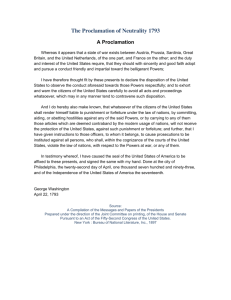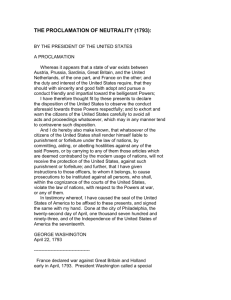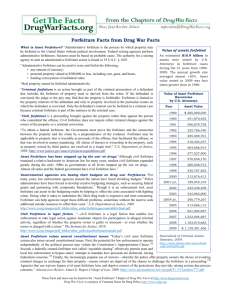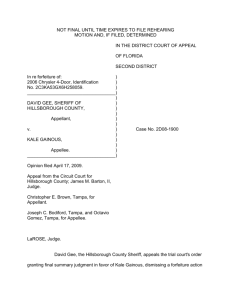Radford Review: Radford Valuation Services
advertisement
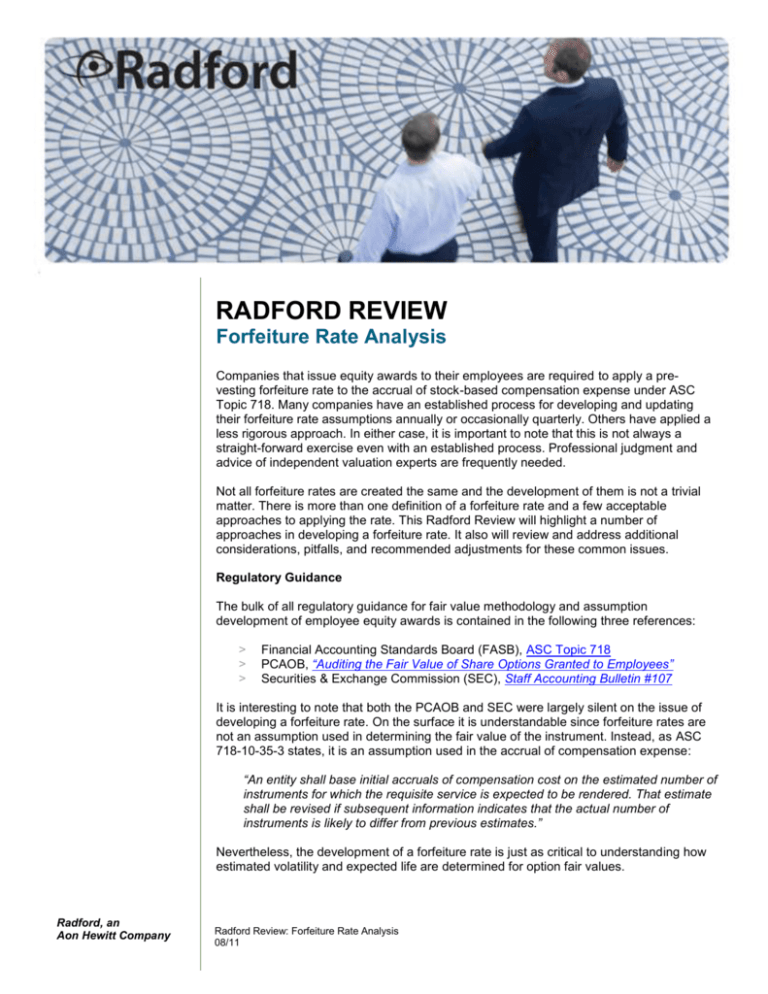
RADFORD REVIEW Forfeiture Rate Analysis Companies that issue equity awards to their employees are required to apply a prevesting forfeiture rate to the accrual of stock-based compensation expense under ASC Topic 718. Many companies have an established process for developing and updating their forfeiture rate assumptions annually or occasionally quarterly. Others have applied a less rigorous approach. In either case, it is important to note that this is not always a straight-forward exercise even with an established process. Professional judgment and advice of independent valuation experts are frequently needed. Not all forfeiture rates are created the same and the development of them is not a trivial matter. There is more than one definition of a forfeiture rate and a few acceptable approaches to applying the rate. This Radford Review will highlight a number of approaches in developing a forfeiture rate. It also will review and address additional considerations, pitfalls, and recommended adjustments for these common issues. Regulatory Guidance The bulk of all regulatory guidance for fair value methodology and assumption development of employee equity awards is contained in the following three references: > > > Financial Accounting Standards Board (FASB), ASC Topic 718 PCAOB, “Auditing the Fair Value of Share Options Granted to Employees” Securities & Exchange Commission (SEC), Staff Accounting Bulletin #107 It is interesting to note that both the PCAOB and SEC were largely silent on the issue of developing a forfeiture rate. On the surface it is understandable since forfeiture rates are not an assumption used in determining the fair value of the instrument. Instead, as ASC 718-10-35-3 states, it is an assumption used in the accrual of compensation expense: “An entity shall base initial accruals of compensation cost on the estimated number of instruments for which the requisite service is expected to be rendered. That estimate shall be revised if subsequent information indicates that the actual number of instruments is likely to differ from previous estimates.” Nevertheless, the development of a forfeiture rate is just as critical to understanding how estimated volatility and expected life are determined for option fair values. Radford, an Aon Hewitt Company Radford Review: Forfeiture Rate Analysis 08/11 Types of Forfeiture Rates There are two common types of forfeiture rates: aggregate and annualized. An aggregate forfeiture rate represents the percent of all awards granted that are expected to forfeit. An annualized forfeiture rate is the aggregate rate adjusted for the vesting schedule and measures the percent of grants forfeited each year. The annualized rate is more common in practice and more flexible since it can be applied to all vesting schedules. Developing Forfeiture Rate There are various sources from which a company can develop a forfeiture rate. We will discuss the usage of historical equity data, headcount turnover, and other data sources. Historical Equity Data The following outlines the steps for developing historical forfeiture rates: (1) Analyze grants and their associated vesting schedule The average vesting period is calculated according to the vesting schedule for each grant and weighted by the number of awards granted. For example, a three-year annual vesting schedule with 33.3% of the awards vesting at the end of each year results in an average vesting time of two years, as shown below: Time (Years) 1 2 3 % Vesting 33% 33% 33% Weighted Average Vest Time Total Vested 0.33 0.67 1.00 2.00 (2) Complete forfeitable periods for cancellations The average forfeitable period is calculated for each cancellation and represents the amount of time an award is exposed to forfeiture. This is based on either the period between the measurement date and the grant date or the average vesting time calculated in (1), whichever is shorter. Note this is only done for pre-vesting forfeitures as forfeiture rate only affects the non-vested shares. (3) Calculate aggregate forfeiture rate The aggregate forfeiture rate is simply the ratio of pre-vesting forfeitures (the awards forfeited less the post-vesting cancellations) over the awards granted. (4) Annualize forfeiture rate Aggregate forfeiture rate is annualized by applying the following formula: The annualized rate takes each vesting schedule into account and captures the time that the award is exposed to the risk of forfeiture. Radford Review: Forfeiture Rate Analysis 08/11 Sample Data The table below illustrates the historical forfeiture by year of grant: Year of Grant Granted Awards Forfeited Awards 2004 2005 2006 2007 2008 2009 2010 1,286,000 1,587,000 2,594,300 2,898,800 2,242,800 2,325,220 1,717,680 321,717 412,092 655,422 772,188 377,321 370,661 260,200 Average 14,651,800 3,169,601 Average Forfeitable Period 2.00 2.00 2.00 2.00 2.00 1.75 0.74 Average Vesting Period 2.00 2.00 2.00 2.00 2.00 2.00 2.00 1.81 2.00 Aggregate Annualized Forfeiture % Forfeiture % 25.02% 25.97% 25.26% 26.64% 16.82% 15.94% 15.15% 13.41% 13.96% 13.55% 14.35% 8.80% 9.43% 19.89% 21.63% 12.58% The table below illustrates historical forfeiture by job class: Job Class Granted Awards Officer Non-Officer 4,824,493 9,827,307 Average 14,651,800 776,867 2,392,734 Average Forfeitable Period 1.83 1.80 Average Vesting Period 2.00 2.00 3,169,601 1.81 2.00 Forfeited Awards Aggregate Forfeiture % Annualized Forfeiture % 16.10% 24.35% 9.13% 14.34% 21.63% 12.58% A few considerations are addressed here to ensure proper adjustments are made when developing the forfeiture rate: Partial Vesting Cycle – In the Sample Data shown above, the awards issued in 2009 and 2010 are only partially through their full vesting schedule. This is reflected by the Average Forfeitable Period being less than the Average Vesting Period. The partial vesting cycle is properly accounted for since the Aggregate Forfeiture % is annualized using the Average Forfeitable Period. Stratification – Often times, stratification of forfeiture rates based on different criteria is necessary. As shown on the second chart above, the turnover rate is 14.34% for NonOfficers while it is 9.13% for Officers. The difference is significant and is a good indication that stratification by Job Class should be considered. In addition, options and restricted stock/RSUs could be analyzed separately as they are frequently granted to different groups of employees. Data Exclusions or Other Adjustments – There may be an unusual number of awards being forfeited when a company implements a reduction in force (RIF), restructures management teams, or undergoes a merger and acquisition. Professional judgment should be used in determining whether certain data should be excluded or adjusted. Future vs. Historical – As the company considers certain adjustments or stratification, a key factor in making these decisions is whether or not the historical data represents the future of the company. If the answer is no, data should be carefully examined and adjusted appropriately. Radford Review: Forfeiture Rate Analysis 08/11 3 Headcount Turnover Another method of estimating forfeiture is to measure turnover by headcount. The headcount turnover is simply the ratio of the number of employees terminated divided by the total number of employees. This is done for each year and the weighted average is calculated based on the number of employees, as illustrated below: Year 2006 2007 2008 2009 2010 Number of Employees 6,170 6,200 6,150 5,980 5,800 Turnover Headcount 640 710 650 500 510 Weighted Average Turnover Rate 10.37% 11.45% 10.57% 8.36% 8.79% 9.93% Although the approach appears straightforward, there are a few factors to consider. The population that is included in the headcount should be consistent with the employees who receive awards. Also, notice that this method places equal weighting on all employees. In reality, executives who receive large grants usually have lower probability of turnover. Skewed results can be created when appropriate weighting is not applied. Other Data Sources A few sources may be considered if companies do not have sufficient historical experience. Radford Trends Report – Supplemental US Salary Increases and Turnover by Region and Industry can be used for forfeiture rate estimation. The reports are released quarterly and group the rates by region, industry, and company size. Society of Actuaries data and behavior study is another alternative for forfeiture rate estimation. The weighted average expected forfeiture is based on the age of the employees at time of grant by applying standard actuarial probabilities of retirement, termination, death and disability. A simplified example of these rates are shown in the following table: Probability of Forfeiture Year 0-1 6.2% Year 1-2 6.9% Year 2-3 6.6% Weighted Average 6.6% Software Considerations Most equity administration software platforms have standard reports that provide the historical forfeiture rates. However, it is critical to understand the type of forfeiture rate being developed and more importantly, the data being used. The standard reports often do not adjust for partial vesting periods of recently issued awards and are limited in their ability to exclude or stratify the data. However, that does not mean the reports should be ignored. It simply highlights the importance of reviewing the information and applying professional judgment when appropriate. Radford Review: Forfeiture Rate Analysis 08/11 Migrating From Spreadsheet to Software It is necessary to reconcile the differences in the forfeiture rate calculation between the spreadsheet and software when migrating from one to the other. Often times, the analysis reveals differences due various approaches. It is important to be familiar with the capabilities of the software and understand whether the input required an aggregate or annualized rate and whether the software is capable of both static and dynamic rates. Summary Several considerations regarding the determination of forfeiture rates have been addressed in this Radford Review. An essential part of developing a reliable forfeiture rate is to use professional judgments in analyzing the historical data to ensure it is representative of what is expected in the future. Regardless of the forfeiture applied to the compensation cost, the company will be required to “true-up” or “true-down” the forfeiture assumption to actual experience. Radford Review: Forfeiture Rate Analysis 08/11 Contact Us For more information, please contact: Jon W. Burg, FSA +1 (415) 315.7137 jburg@radford.com Harmony Chi, ASA +1 (415) 315.7133 hchi@radford.com Locations Austin, Bangalore, Beijing, Boston, Chicago, Hong Kong, London, New York, Philadelphia, San Francisco, San Jose, Shanghai and Singapore Jon W. Burg, FSA Vice President Jon Burg is vice president and West Coast Practice Leader of Radford Valuation Services, the equity valuation group of Radford, an Aon Hewitt Company. He has thirteen years of benefits and compensation consulting experience, including all forms of equity compensation. Jon collaborates directly with management and compensation committees to design sound equity compensation plans, practices and procedures. He also works with companies on the valuation and financial management of their retirement and equity compensation programs, leveraging an extensive actuarial background to provide rigorous analysis of historical plan experience. He earned a bachelor of science in mathematics and economics from the University of Washington. He is a Fellow of the Society of Actuaries and an Enrolled Actuary. Jon frequently speaks on a variety of equity compensation topics at industry events, including national and local NASPP conferences. Harmony Chi, ASA Analyst Harmony Chi is an analyst with Radford Valuation Services, the equity valuation group of Radford. She has consulted on a variety of employee equity compensation issues, including the valuation and financial reporting of employee stock options and ESPPs under Topic 718, design and valuation of underwater stock option exchanges, and complex valuations of performance-based awards. Harmony graduated from University of California at Berkeley with a bachelor of science degree in mathematics. She is an Associate of the Society of Actuaries. Harmony is based in San Francisco, California. About Radford Radford is the industry leader, providing advice and benchmarking to technology and life sciences companies to address their toughest HR and rewards challenges: attracting, engaging and retaining talent. Our advisors provide industry-specific expertise, applying an analytical approach that integrates market data, trends and our experience in working with nearly 2,000 companies – from Global 1000 firms to start-ups – to balance the needs of executives, employees and shareholders. Our advice is customized to a client’s unique situation to ensure your rewards programs are not just competitive - but can be a competitive advantage. Radford’s uniquely data-driven perspective is why more technology and life sciences companies, and their Board of Directors and Compensation Committee, trust Radford for compensation data and advice than any other firm. Radford clients rely upon our global survey databases of more than four million incumbents for real-time insight on total compensation levels, practices and emerging trends to inform their HR and reward strategies. Headquartered in San Jose, CA, we have professionals in Austin, Bangalore, Beijing, Boston, Chicago, Hong Kong, London, New York, Philadelphia, San Francisco, Shanghai and Singapore. Radford is an Aon Hewitt company. Visit www.radford.com, or for more information, contact info.rad@radford.com. Radford Review: Forfeiture Rate Analysis 08/11
